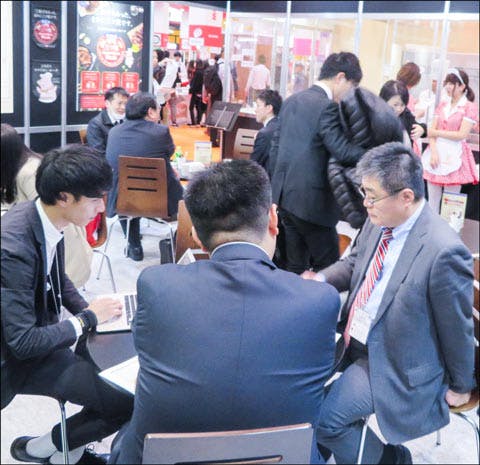New Ideas for U.S. Beef, Pork Introduced at ‘Competitive’ FOODEX in Japan
Facing growing competition in Japan and other Asian markets, USMEF promoted U.S. red meat by offering new dishes and fresh ideas for U.S. beef and pork to importers, distributors, processors, foodservice operators and retailers attending the annual FOODEX trade show in Tokyo. Funding by the USDA Market Access Program (MAP), the Beef Checkoff Program and the National Pork Board, connected USMEF members to thousands of potential customers who sampled U.S. beef and pork inside the show’s USA Pavilion.

U.S. pork mascot Gochipo poses for photos at the USMEF booth at FOODEX
Attendance for the four-day event was estimated to be 80,500 people – a 10 percent increase over 2018. Vendor participation was higher as well, and USMEF Vice President for International Marketing Programs Greg Hanes said an increase in competition at the 2019 show was quite noticeable.

Samples of U.S. beef and pork dishes – some of them new to Japanese consumers – were handed out at the USMEF booth
“FOODEX is always an exciting place for those in the export industry and has become the largest food-related exhibition in the Asian Pacific region, so it offers U.S. red meat a lot of opportunities,” said Hanes, who joined other staff members at the USMEF display booth. “What really stood out at this year’s show was the competition and how aggressive our competitors were due to the various trade agreements that have been reached and the fact the U.S. doesn’t have an agreement with Japan. Some competing countries were new to FOODEX and some returned after an absence of several years. This shows how valuable a market Japan has become.”
Strategies to promote U.S. beef at FOODEX this year included the introduction of Idaho finger steak, nuggets of steak fried to create bite-sized morsels. USMEF developed special panels and recipe cards and distributed them to FOODEX attendees.
“This is a new item we promoted with support from the Idaho Beef Council and it was really a hit at the show,” said Hanes. “The idea of frying beef is quite new to the hotel and foodservice buyers and managers who visited the USMEF booth. After sampling the fingers, many of them said they would consider putting it on their menus. It was definitely the most requested item we served over the four days.”

USMEF connected member companies to meat importers interested in U.S. beef and pork during the four-day FOODEX show
Uruguay was quite visible in its promotion of beef and Canada was strong in promoting pork and beef, Hanes noted.
“The Japanese market, and really the region as a whole, is becoming more accessible for a wider range of exporting countries,” he added. “Because of this, we need to be really active at events like FOODEX and counter what the competition is promoting, despite the disadvantage we have right now of not having a trade agreement with Japan.”

Visitors to the USMEF booth participated in an “American beef virtual tour: Farm to Table,” featuring an American ranch and feedlot through a virtual reality video program
USMEF also promoted U.S. beef at FOODEX in an “American beef virtual tour: Farm to Table,” a display where visitors were able to see an example of an authentic American ranch and feedlot through a virtual reality video program. The one-hour video, produced by the National Cattlemen’s Beef Association through support from the Beef Checkoff Program and the Iowa Beef Industry Council, was designed to present U.S. beef production practices.
On behalf of U.S. pork, USMEF introduced to FOODEX visitors its Mitsuboshi, or “Three-starred American Pork,” campaign that was launched late last year. The promotion focuses on three advantages of U.S. pork: tenderness, tastiness and juiciness.
“USMEF-Japan has been emphasizing the quality of U.S. pork by highlighting scientific data that show its advantages over domestic pork and some of our other competitors in the market,” explained Hanes “The campaign also explains the affordability of U.S. pork due to lower production costs and efficiency.”
At its booth, outfitted with a small kitchen, USMEF served U.S. pork tenderloin tonkatsu and grilled salt pork prepared with a low-temperature cooking method. U.S. pork fried back rib and loin steak with special sauce developed by a Michelin-starred French chef were also served.
To relate to Japanese consumers in attendance, U.S. pork mascot Gochipo made appearances at the show and mingled among visitors to the USMEF booth.
